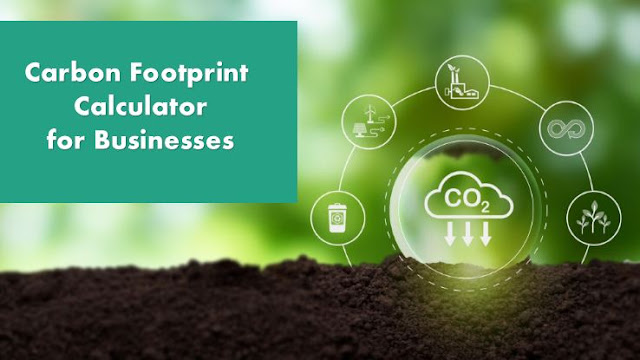Carbon
In today’s world, businesses have a crucial role to play in addressing climate change. Understanding and measuring their carbon footprint is a fundamental step towards adopting sustainable practices.
A carbon footprint calculator tailored for businesses provides valuable insights into their environmental impact.
This article explores the importance of using such calculators, backed by facts and data.
Data and Facts Carbon Footprint Measuring Calculator
Measuring the carbon footprint of a business involves quantifying the greenhouse gas emissions resulting from its operations, including energy consumption, transportation, waste generation, and supply chain activities.
Here are some data and facts related to carbon footprints of businesses:
1. Emissions Breakdown
According to the Intergovernmental Panel on Climate Change (IPCC), globally, around 71% of greenhouse gas emissions come from energy production, 14% from industry, and 11% from agriculture, forestry, and other land-use.
2. Supply Chain Emissions
A significant portion of a business’s carbon footprint can be attributed to its supply chain activities. The Carbon Disclosure Project (CDP) reports that, on average, supply chain emissions are four times higher than a company’s direct emissions.
3. Scope 1, 2, and 3 Emissions
The Greenhouse Gas Protocol categorizes emissions into three scopes. Scope 1 includes direct emissions from owned or controlled sources, Scope 2 includes indirect emissions from purchased electricity, and Scope 3 encompasses indirect emissions from activities such as business travel, procurement, and waste disposal. Scope 3 emissions often represent the largest share of a company’s carbon footprint.
4. Carbon Intensity
Carbon intensity is a measure of emissions per unit of output or revenue. It helps businesses assess their efficiency and identify areas for improvement. The World Resources Institute (WRI) states that carbon intensity can be reduced by adopting energy-efficient technologies and cleaner energy sources.
By utilizing a carbon footprint calculator specifically designed for businesses, companies gain valuable insights into their environmental impact. These calculators use various data inputs, including energy consumption, transportation data, waste management practices, and supply chain information, to estimate greenhouse gas emissions. With this data, businesses can:
– Identify Hotspots: A carbon footprint calculator allows businesses to identify the major sources of emissions within their operations. It highlights areas where emissions reduction efforts can be focused, such as optimizing energy usage or improving logistics and transportation.
– Set Reduction Targets: Armed with accurate data, businesses can set realistic and ambitious reduction targets. This provides a roadmap for achieving sustainability goals and demonstrates commitment to stakeholders.
– Track Progress: Regularly using a carbon footprint calculator enables businesses to monitor and track their progress over time. It helps evaluate the effectiveness of implemented measures and identify areas for further improvement.
– Make Informed Decisions: By understanding their carbon footprint, businesses can make informed decisions that align with their sustainability objectives. They can choose suppliers and partners with lower emissions, promote energy-efficient practices, and invest in renewable energy projects.
Conclusion Carbon Footprint Measuring Calculator
Measuring and understanding a business’s carbon footprint through the use of a dedicated calculator is a vital step towards adopting sustainable practices.
It provides crucial data to identify emission hotspots, set reduction targets, track progress, and make informed decisions.
By taking proactive steps to reduce their environmental impact, businesses can contribute to a greener future and demonstrate leadership in tackling climate change.
https://www.exaputra.com/2023/06/carbon-footprint-measuring-calculator.html
Renewable Energy
Election Fraud Doesn’t Merit Jail Time? Guess Not
 From “The Grio”:
From “The Grio”:
Austin Smith, a former Republican state representative in Arizona, has pleaded guilty to charges for forging signatures on his 2024 re‑election campaign petitions. He admitted to submitting nomination papers with names of deceased individuals and other forged entries. The plea agreement calls for probation, a fine of $5,000 and a five‑year ban on seeking public office. Meanwhile, Smith had served as a senior director (and briefly strategic director) of Turning Point Action, the 501(c)(4) advocacy arm of the conservative youth group Turning Point USA and resigned from that leadership role when the allegations surfaced. Through his dual role as lawmaker and conservative organizer, Smith’s case underlines questions of campaign integrity and the responsibilities of politically active organizations.
I would have thought (and hoped) that election fraud would merit some jail time.
Renewable Energy
Why Not Behead Dissidents? It Worked for Millennia
 A segment of Newsmax tonight began with many clips from commentators from both parties saying that Donald Trump is the most powerful person in the word. “All right, enough!” the host finally interjected. “Well, if he is the most powerful person in the world, why can’t he appoint whoever (sic) he wants to prosecute James Comey and Letitia James?”
A segment of Newsmax tonight began with many clips from commentators from both parties saying that Donald Trump is the most powerful person in the word. “All right, enough!” the host finally interjected. “Well, if he is the most powerful person in the world, why can’t he appoint whoever (sic) he wants to prosecute James Comey and Letitia James?”
Well, we do have a few sticking points here.
We have the U.S. Constitution, and 200+ years of rule of law, and the concept that no one is above the law.
And we have the question, “Given that they have taken stances against Trump, why not have them both summarily beheaded?” Given that we no longer have a balance of powers among the supposedly three co-equal branches of government, what’s the big deal?
Three hundred years ago, that’s precisely would have happened to people who took public stances against a king.
We either stand for freedom and loyalty to a constitution — or we don’t. We can’t have it both ways.
Renewable Energy
Solar PV on a Car’s Roof
 There is no need to physically attach solar panels to your car’s roof to determine if it will charge your car. Of course it will while it’s in the sun. Let’s do some math:
There is no need to physically attach solar panels to your car’s roof to determine if it will charge your car. Of course it will while it’s in the sun. Let’s do some math:
If:
The area of this Tesla’s roof is 2 square meters (being generous),
The efficiency of the panels is 25%,
The capacity factor of solar (depending on your location) is 20%,
The sun’s irradiance is 1000 watts per square meter,
The Tesla’s battery capacity is 100 KWhrs,
And we neglect the increased weight and drag of the array,
We’re talking about 100 hours, more than 4 days.
Doesn’t sound like a bargain, especially considering that if you overbuild the solar array on your roof and charge your car in your garage, you’ve achieved the same goal at far less expense and inconvenience.
-
Climate Change4 months ago
Guest post: Why China is still building new coal – and when it might stop
-
Greenhouse Gases4 months ago
Guest post: Why China is still building new coal – and when it might stop
-
Climate Change2 years ago
Spanish-language misinformation on renewable energy spreads online, report shows
-

 Greenhouse Gases2 years ago
Greenhouse Gases2 years ago嘉宾来稿:满足中国增长的用电需求 光伏加储能“比新建煤电更实惠”
-
Climate Change Videos2 years ago
The toxic gas flares fuelling Nigeria’s climate change – BBC News
-

 Climate Change2 years ago
Climate Change2 years ago嘉宾来稿:满足中国增长的用电需求 光伏加储能“比新建煤电更实惠”
-

 Carbon Footprint2 years ago
Carbon Footprint2 years agoUS SEC’s Climate Disclosure Rules Spur Renewed Interest in Carbon Credits
-
Renewable Energy5 months ago
US Grid Strain, Possible Allete Sale









